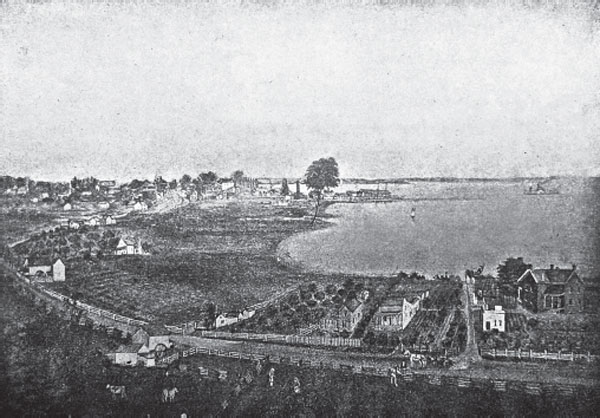
Artist rendering of New Baltimore and Anchor Bay in 1877. New Baltimore Historical Society Collection.
Anchor Bay is located in the northeast corner of Lake St. Clair. The large bay, along with the rest of Lake St. Clair, has played a big part in this area’s history.
The lake itself joins the Detroit River to the St. Clair River and is the smallest body of water in the Great Lakes system. One of the things that is so interesting about Lake St. Clair is that you can get literally anywhere in the world by water from here. This is possible because it helps connect all of the Great Lakes together.
While the lake may be small, it has a long history of being internationally significant in the shipping of many products and resources to other parts of the United States and the world. During Prohibition, the lake, because of its location between southern Ontario, Canada, and southeast Michigan, became a hotbed for rumrunning and the transport of other illegal alcoholic beverages. Many of the towns along Anchor Bay gladly participated in such activities.
Long before the French discovered this area, it was visited frequently by Native Americans. Some of the many Native American burial sites that have been studied date back to 9000 BC. In the 1960s, Dr. James Edward Fitting from the University of Michigan excavated a Native American site and wrote extensively about his findings. It was his belief that the Native Americans came to this area to bury their dead, not so much to live here. In addition, he noted that many archaeologists have theorized that some tribes traveled for weeks, even months, to get to this area, not only to bury their dead, but also to hold a ceremony that may have been the precursor to the Feast of the Dead celebrated by many Native Americans in the seventeenth century.
Archaeologists who have excavated several different sites in the area found that some of the skulls had circular discs removed, and the skulls were packed with clay. Some of the burials were found to have extra skulls that were often placed close to the waist area of the skeletons. It is surmised that perhaps these skulls were part of a belt that was worn by the deceased as if they were trophies.
The Anchor Bay and Lake St. Clair area remained pretty much untouched except for the Native American presence until it was discovered in 1679 by French explorer Robert de la Salle, Father Louis Hennepin and thirty-one crew members aboard the Griffon, which had set sail from Niagara Falls in search of new territory. While some historians disagree about how the lake was named, it’s generally thought that the lake was named in honor of Saint Clara of Assissi, whose feast was celebrated on the same day the lake was discovered.

Artist rendering of New Baltimore and Anchor Bay in 1877. New Baltimore Historical Society Collection.
However, long before this, Lake St. Clair went by many different names by various Native American tribes. The Mississaugas, who by the late seventeenth century had established a village by the lake, called it Waawiyaahtaan, meaning “at the whirlpool.”
The early French mapmakers used a variety of French and Iroquois names that included, but aren’t limited to, Lac des Eaux de Mer, which means “seawater lake,” and Lac Ganatchio, meaning “kettle,” because of the shape.
Other Native American names for Lake St. Clair have to do with things that are sweet, because the lake is fresh water and not salt water. Those names include Otsikea, Kundequio, Oiatinatchiketo and Oiatinonchikebo, all roughly translating into words having to do with candy or other sweet treats.
Over time, the Native Americans were moved to three reservations along the Anchor Bay coast and, eventually, either to the Trail of Tears or to Canada. Many Native American burial sites have been destroyed, although steps have been taken to protect some of the burial grounds. There may be Native American sites that have yet to be discovered.
Over a brief period of time, the area became settled, and the town of New Baltimore became a major shipping port on the Great Lakes that further boosted the economy and settlement of the Anchor Bay region.
While Lake St. Clair is still a crucial shipping channel on the Great Lakes, it is now widely known as a favorite boating destination and a fisherman’s dream.
From a paranormal perspective, some may say that the Anchor Bay area is the “perfect storm.” There are large bodies of water, Native American burial grounds and a couple of major ley lines running through the area. Some, if not all, of these characteristics could be large contributors to the abundance of paranormal activity in the area.
Many of the people who live or at one time lived in the Anchor Bay area don’t seem at all surprised by the amount of paranormal activity. In fact, they would be more surprised if no ghosts or spirits returned to the area after they passed on.
One resident summed it up like this: “Who wouldn’t want to come back here? The area is so rich with history and such a beautiful place to live that a lot of people who’ve moved away still long to return to the area someday. There’s something about this place that gets in your blood and stays with you your entire life.”
That pretty much sums up why so many ghosts and spirits may choose to return to the Lake St. Clair area, and this probably explains it better than any of the fancy explanations some paranormal investigators offer up to explain the plethora of paranormal events in the region. It’s simply a fabulous place to work, live and, apparently, haunt.